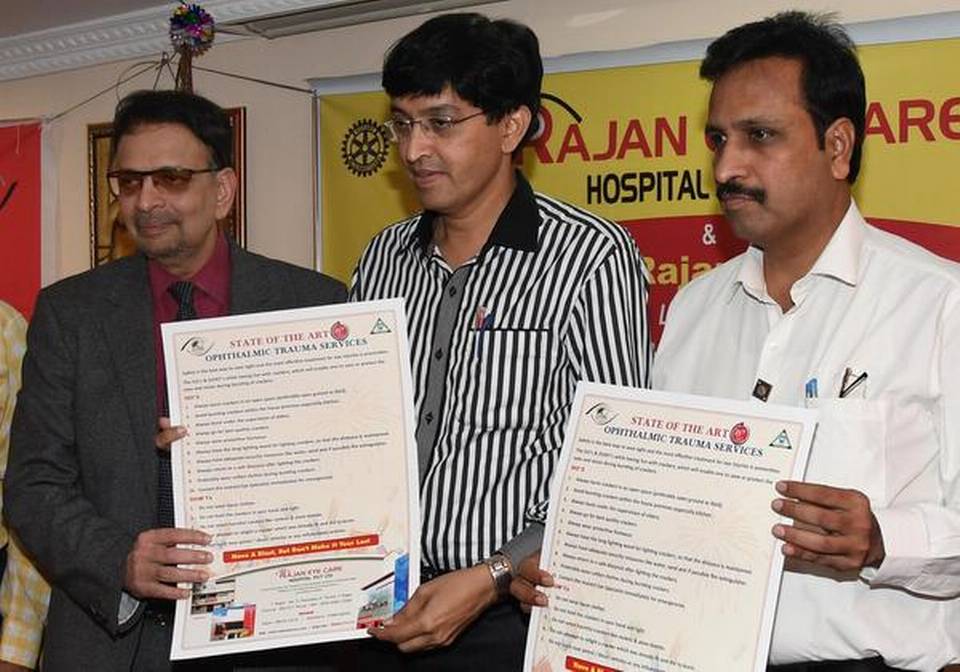Monthly Archives: October 2018
A rare triumph for aspiring scriptwriters
Varun Rajendran’s case a precedent of sorts for those looking to safeguard their intellectual property
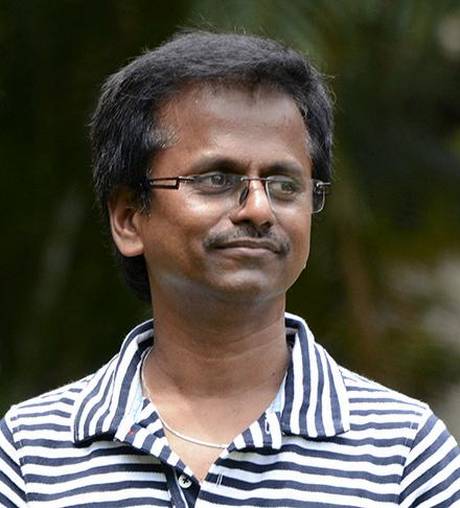
In what is being considered a rare triumph for aspiring writers and film-makers, A.R. Murugadoss, who has directed actor Vijay’s Deepavali release, Sarkar, has agreed to add a 30-second card admitting to the fact that aspiring film-maker Varun Rajendran conceived the same idea several years ago.
Stating that the screenplay written by Murugadoss for Sarkar and Rajendran’s script titled ‘Sengol’ were similar, K. Bhagyaraj, president, South Indian Writer’s Association, said, “As a creator, A.R. Murugadoss said that he has worked hard on the film and felt it was unfair. But, I told him that the concept of the film was the same and Varun Rajendran had thought of the same concept 10 years ago. When I insisted that he should recognise the similarity, Murugadoss acceded to my request.”
For his part, Murugadoss released a video clarifying that film’s story, screenplay and direction will be credited to him only. “Bhagyaraj requested that we should encourage Varun Rajendran’s effort to have conceived a script with the same ‘spark’ (of a man losing his vote in the elections) even though there are no further similarities with Sarkar. In that way, I agreed to put a card in the beginning,” said A.R. Murugadoss.
This is the second time Murugadoss has faced allegations of intellectual property theft. Film-maker Gopi Nainar, who made Arram, had made serious allegations that actor Vijay’s last film with Murugadoss, Kaththi, was his story.
No safeguards
Sarkar’s case has nevertheless opened up a space in Tamil cinema about the vulnerability of budding writers/filmmakers in Tamil cinema and how they can safeguard their intellectual property. Often, young film-makers are asked to narrate scripts and stories without any safeguards for their intellectual property. Unlike in the U.S., registration of screenplay is not an easy process in India, which puts off screenwriters. However, copyright lawyer M.V. Swaroop says that while ‘registering’ the script can be done to safeguard intellectual property, it is not necessary in court of law. “An idea cannot be copyrighted. Only an expression of an idea can be copyrighted,” said Swaroop.
He further said that there was a copyright infringement only when it could be proved that a second literary piece of work could exist without the first work. Tamil Film Producer Council’s treasurer S.R. Prabhu insists that the writers’ union should spread awareness about safeguarding copyrights.
source: http://www.thehindu.com / The Hindu / Home> News> Cities> Chennai / by Udhav Nag / Chennai – October 31st, 2018
34
Ophthalmic trauma services launched
Round-the-clock ophthalmic trauma services were launched at Rajan Eye Care Hospital on Tuesday.
Inaugurating the services, Health Secretary J. Radhakrishnan urged young ophthalmologists to learn skills and take it to the remotest of villages.
Golden hour
Mohan Rajan, chairman and medical director, Rajan Eye Care Hospital, said ocular trauma has become an important aspect of eye care. “It is important to bring persons who have sustained eye injuries to an ophthalmologist within an hour, the golden hour. Many of the trauma cases can be grievous,” he said. He added that ophthalmic trauma could be due to chemicals — acid and alkali — sports, road traffic accidents and physical violence or assault.
About In fact, 45% to 50% of ocular injuries in children occurred at home because of the negligence of parents, he said adding that children are more likely to sustain eye injuries than adults. Sometimes, trauma can also have a late effect on the eyes. “There could be effects after three months. This included retinal tear and detachment. Hence, close follow-up is needed,” Dr. Rajan said.
With Deepavali round the corner, he said there were many injuries caused by crackers too. He reiterated the importance of treating ophthalmic trauma as an emergency. Pamphlets on do’s and don’ts while bursting firecrackers were released on the occasion. Sujatha Mohan, executive medical director of the hospital, Babu Peram, district governor, Rotary International District 3232 and Sathyanarayanan, president, Rotary Club, T. Nagar were present.
source: http://www.thehindu.com / The Hindu / Home> News> Cities> Chennai / by Staff Reporter / Chennai – October 31st, 2018
32
Sports scribe Sudarsan passes away
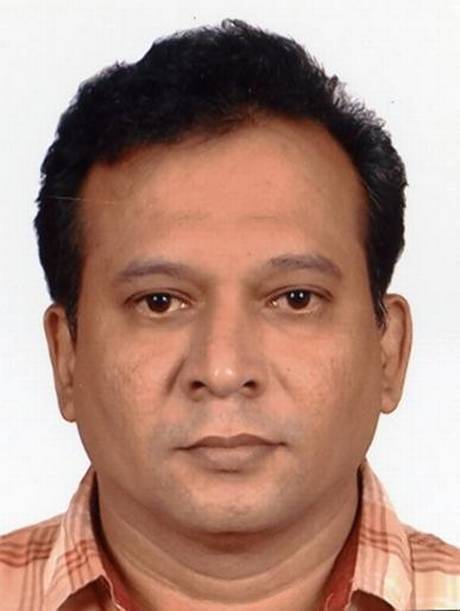
S. Sudarsan, Senior Assistant Editor (Sports) of The Hindu, passed away here on Tuesday morning. He was 43 and is survived by his wife, a son and a daughter.
Sudarsan, who joined The Hindu Sports Desk in 2001, was a meticulous sub-editor with an eye for detail. A keen sportsman, who played cricket, tennis and football regularly, Sudarsan was a driving force behind many special football and tennis features in the sports pages of The Hindu. He had covered La Liga and Bundesliga for the newspaper.
An active member of the Tamil Nadu Sports Journalists Association (TNSJA), Sudarsan had led the South Zone cricket team to victory in the J.K. Bose tournament in Thiruvananthapuram last year. The Sports Journalists’ Federation of India and TNSJA condoled the demise of Sudarsan.
source: http://www.thehindu.com / The Hindu / Home> Sport / by Special Correspondent / Chennai – October 30th, 2018
30
An apostle returns: Bringing St. Thomas back to Chennai
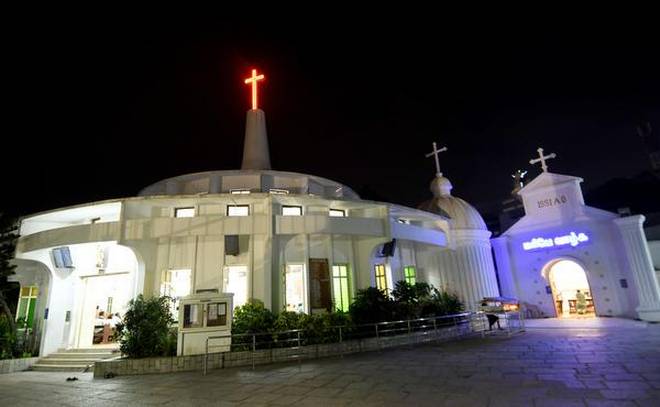
St. Thomas is largely credited with bringing Christianity to India
When Reverend Father P.J. Lawrence Raj was an assistant priest in Chennai, he wrote many letters to the bishops of the Catholic world. When he didn’t get a response, he wrote to Christian magazines.
His letters were an attempt to solve a new-age problem afflicting a historical icon: in a saturated religious marketplace, he was seeking brand recognition for St. Thomas, one of the 12 apostles of Jesus and the man largely credited with bringing Christianity to India through the Malabar coast in 52 AD.
Fr. Raj composed these letters over 30 years ago, on St. Thomas Mount, a hillock overlooking Chennai’s airport. Two thousand years ago, when there was no airport, no flights roaring overhead, and when most of the surrounding land was dense forest, it is believed that the apostle Thomas was murdered by a group of Hindus who did not fancy his proselytising.
“I have a special attachment to him,” says Fr. Raj. “He was a great witness for faith. We are all Doubting Thomases — we don’t believe easily.”
Fr. Raj, who was ordained 36 years ago, has served at some of the Ivy League institutions of Chennai’s Catholic world — Santhome Basilica, where Thomas is buried; Velankanni Church, dedicated to Mother Mary, and now Little Mount, where the apostle is believed to have hidden from his murderers inside a grotto.
Thomas is believed to have lived, and preached, in the Chennai region for over 13 years. As one of the original Twelve, he has built-in brand recognition. There are churches, roads and even hospitals named after him. But of late, he is no longer the draw he once was; festivals dedicated to his memory are in the shadow of others, notably the Velankanni festival, which draws the faithful in their thousands.
Neglected saint
“Two thousand years is a long time,” Fr. Raj muses. “What happened after St. Thomas was martyred and till the Portuguese came, we don’t know. The Portuguese gave more importance to Our Lady. To be very frank with you, it is the people of Kerala who are more attached to St. Thomas; they call themselves St. Thomas Christians. In Tamil Nadu, we have more of an attachment towards St. Francis Xavier, or recent saints like Mother Teresa. And when Velankanni Church came up in Besant Nagar in the 1970s, our devotion to Our Lady became stronger. Perhaps priests didn’t take the initiative, but I think we have neglected St. Thomas.”
Fr. Raj’s efforts to bring Thomas back to the mainstream narrative of Chennai’s Roman Catholic world reads like a marketing campaign: High-level initiatives include a renovation, in the early 2000s, of the Santhome Basilica where the remains of the apostle were buried in a crypt below surface level. Members of his parish nicknamed him ‘Father Renovation’ as he orchestrated a slew of beautification and restoration projects in his parish churches, including St. Teresa’s Church in Nungambakkam, even as he faced allegations of corruption and misappropriation of funds. “I tell people that ‘that this tomb of Thomas is the womb of Christianity in India’ — without Thomas, Christianity would not have come to India so early, and here at Little Mount, I am trying to do the same work I did at Santhome.”
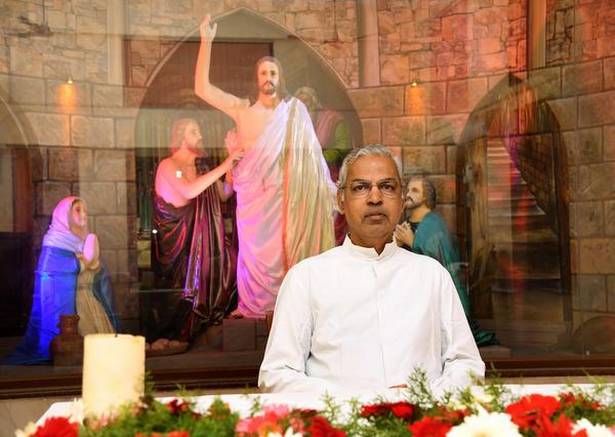
Outside, on the sloping grounds of Little Mount Church, a short-statured, elderly man dressed all in white with a black belt takes up the story. D’Cruz knows four languages, and claims to have a connection with Thomas “that nobody else has”.
The church’s local guide steers you in the direction of the grotto, pausing to point out the spots where Thomas placed his hand, his foot, his knee. Gesturing at a narrow opening in the cave, he says, “This was not an open space, but when Thomas prayed and needed to escape, it opened up.”
Reviving Thomiyar
He ticks all the boxes: the bleeding cross, the holy fountain where Thomas quenched his thirst during those last hours (whose water is now sold in plastic bottles for a nominal fee), and even tells me a slice of his own personal story. “For me, it is 100% Jesus,” D’Cruz says. “He and the Mother have brought me to Thomiyar.”
He sees a group of Korean tourists approaching, and breaks off our conversation. “Excuse me, over here!” he calls out, in suddenly accented English. “Do you want to know about Thomas?”
D’Cruz is a grassroots ambassador for Thomas, and fits in with Fr. Raj’s plan to make the apostle relevant again. His compatriot Aubrey Laulman, an Anglo-Indian who started working at the church eight years ago, after settling his daughters in marriage, performs a similar function at St. Thomas Mount. He says he was hesitating on the steps leading up to the mount when he felt a gentle but irresistible push on his shoulder. “It was a miracle,” he says, drawing my attention to the cross believed to have been hand-carved on the rock by Thomas himself.
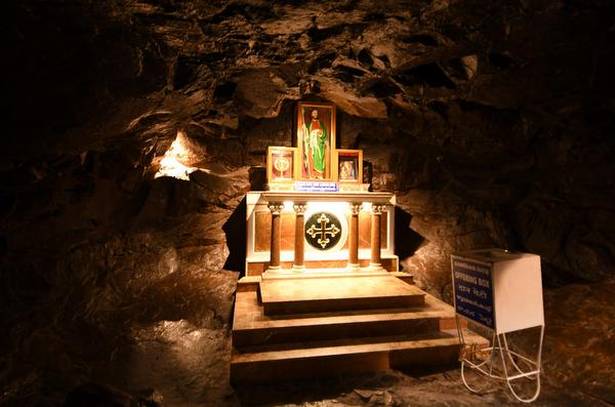
“Look at it from different angles, you will see how intricate the work is,” Laulman points out. “Those days, people prayed a lot. That’s why Thomas was able to do so many miracles. They prayed a lot because there was no Tata Sky,” he says, laughing at his own punchline, the sound of his delight bouncing off the empty walls of his church. “Don’t mind me, I am very frank.”
D’Cruz and Laulman are spreading the story of St. Thomas among those who visit the two churches, but Fr. Raj’s focus is on those who don’t even make it as far. “After I took over the parish two years ago, we have made The Feast of St. Thomas an 11-day affair, not three,” he says, as we pick our way gingerly across the debris of building work. “We are renovating the entire church; we will make the festival as popular as The Feast of Our Lady, which is celebrated after Easter. It is time to focus our attention on St. Thomas, to give him publicity, and get the parishioners and the public involved in the story.”
This essay is from a National Geographic Society and Out of Eden Walk journalism workshop.
source: http://www.thehindu.com / The Hindu / Home> Society> Field Notes> Sunday Magazine / October 27th, 2018
26 b
Boys from Vepery: A fascinating story about the Irish migration to India
A documentary, titled Boys from Vepery by Fokiya Akhtar, explores the migration of members of the Irish community to India during the Great Famine of Ireland during 1840-50.
Ian Michael, professor of marketing at Zayed University, Dubai, has vivid memories of listening to stories told by his great-grandmother, Agnes Footman, when he was 12 years old. Sipping grog in an old-style British home at Hyderabad’s Sarojini Devi Road, Agnes would tell of her great grandfather’s family of fighters and revolutionaries who migrated to India during the Great Famine of the 1840s and ’50s. She would go on for hours, talking about the valour and lineage of these Irishmen. As a child, the thing that stood out most for Ian was his family’s accent — an unusual mix of Irish and Indian.
About 40 years later, when he mentioned his Irish connection to Fokiya Akhtar, a fellow professor at the university, she said the story had the potential for a documentary. In the next few months, Michael and Akhtar had multiple sittings and locked the script for the documentary, Boys from Vepery, which they plan to release in mid-2018.
“The protagonist of the documentary is John Footman. He was my great-grandmother’s grandad. Footman was a famine migrant who travelled by ship from Ireland to Vepery, Madras, in 1847 as enlisted Irish fusiliers with the British East India Company. My mum’s mother also came from Irish stock. Her grandfather, William Curran, sailed as a 10-year-old boy from Ireland with his father Patrick and his three sisters,” Michael told HT, via email.
The documentary traces John Footman’s family to Clonakilty, a town in County Cork, Ireland.
Most of the Footmans served in the Army and Railways. After the Sepoy Mutiny of 1857, the British East India Company was disbanded and John Footman joined the British Army. He married a woman called Matilda, who was most likely Mangalorean. Their eldest son, Patrick, joined the British Railways in Madras. Patrick’s daughter Agnes (Michael’s great-grandmother) left Madras with three of her brothers to settle in Secunderabad. She married Lewis Francis, a senior railway line inspector with the then British railways.
“My grandmother Joyce Curran was the Station Master of Nampally (a Hyderabad suburb) station in the 1960sand ’70s. Her brothers, the Currans, were divers at the Mazagaon docks in Bombay. They migrated to the UK a few years after India got independence,” says Michael.
In India, the Footmans kept to themselves, mostly interacting with members of the Irish-Indian and Anglo-Indian communities. The only Indians they interacted with were the people they worked with. Nor did they imbibe the Indian culture. The women of the family never wore Indian clothes.
All their weddings were held at two Parsi community centres – the Zoroastrian Club and Percy’s hotel in Secunderabad. And their dances, especially at Christmas and New Year’s Eve, would involve lots of dancing and drinking, just like they would have back home in Ireland.
Picnics centred on fishing and shooting. Michael remembers going with his uncles and grand uncles, fishing and shooting in the forests of Andhra Pradesh, including Nizamabad.
For research, Michael made multiple visits to Ireland to obtain baptism and death certificates; went through the records of the British Indian Army and the Chelsea Hospital. He began investigating the Curran side of the family, but ended up getting more details about the Footmans. “I met relatives. We were several generations apart during filming and this feeling was nostalgic, filled with unique emotions,” Michael says.
Michael uncovered during his research a fascinating connection with General Michael Collins, a politician and soldier who spearheaded the struggle for Irish independence in the early 20th century and became the leader of the provisional government of the Irish Free State. “I discovered that John Footman’s mother was one Joan Collins, who came from the same village as General Collins,” says Michael.
He also stumbled upon the information that the ancestors of the late US President John F Kennedy, Margaret Field and James Hickey, came from Clonakilty and surrounding villages too. “So while John Footman chose to use the Indian Ocean route and came to India in 1847, his probable mates, the Fields and Hickeys, chose the Atlantic-to -Newfoundland route and went to Boston,” Michael says.
source: http://www.hindustantimes.com / Hindustan Times / Home> Art & Culture / by Danish Raza, Hindustan Times / May 21st, 2017
